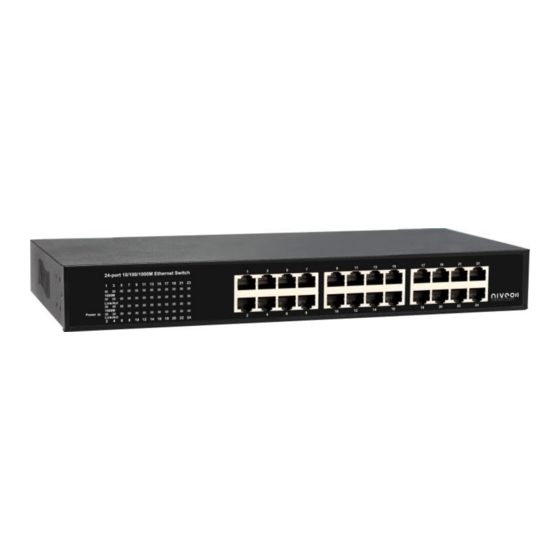
Advertisement
Quick Links
Advertisement

Summary of Contents for Niveo NGS24U
- Page 1 NGS24U 24 Port 10M/100M/1000M Desktop Gigabit Ethernet Switch User’s Manual...
- Page 2 Web Smart Switch Ⅰ . Features Overview Supports real-time status (link, speed, duplex) of each port Supports port setting for enable or disable operation (the 1st port can’t be disabled) Supports port setting for N-Way or force mode operation Supports Broadcast Storm Protection Supports Port-bases VLAN Supports priority queues for QoS Ⅱ...
- Page 3 Step 3: Open the browser (like IE…) and go to http:// 192.168.2.1 You will see the login screen as below: Please key in the password to pass the authentication. Password: admin After the authentication procedure, the switch can be used now. Step 4: On the home page, select the configuration by clicking the icon as below:...
- Page 4 Configuration: System Configuration It shows system status, such as: MAC address, system firmware version and so on. You can change the user name, the password and IP address, and click “Apply” to confirm the new change. Afterwards, you can reset the switch by turning off and turning on it to take the new user name, the password and IP address effectively.
- Page 5 Configuration: Port Configuration You can enable or disable Jumbo Frames by clicking the checking box. Select the “Port no.” which you want to configure the mode below, - Auto speed - enable/disable the port - 10M/100M/1000M - full/half-duplex - enable/disable flow control - 4 -...
- Page 6 Configuration: VLAN Configuration There are 16 VLAN groups. Select and add a group into “VLAN ID” and then click the port number which you want to put into the selected VLAN group. - 5 -...
- Page 7 Configuration: Aggregation/Trunk Configuration Set up port trunk groups and then click the port number you want to include into the same group. There are eight groups to choose and the maximum for one group is 24 ports. - 6 -...
- Page 8 Configuration: LACP Port configuration Select the port number which you want to enable/disable its protocol. - 7 -...
- Page 9 Configuration: RSTP Configuration Select the port number which you want to enable/disable its protocol. - 8 -...
- Page 10 Configuration: 802.1x Configuration Select the “Port no.” which you want to configure the mode below, - Auto - Force Authorized - Force Unauthorized - 9 -...
- Page 11 Configuration: IGMP Configuration You can enable or disable IGMP by clicking the checking box. Select the “Port no.” which you want to configure the mode. - 10 -...
- Page 12 Configuration: Port Mirror configuration Port Mirroring is for mirror the traffic from Source port to Destination port. Select the Destination port from port 1 to port 24, and then select the Source port by clicking the checking box of each port. - 11 -...
- Page 13 Configuration: QoS Configuration You can enable or disable QoS by clicking the checking box. If you enable QoS, you can select the class of service for each port. - 12 -...
- Page 14 Configuration: Filter Configuration Select the “Port no.” which you want to configure the mode to enable/disable filtering IP address. - 13 -...
- Page 15 Configuration: Rate Limit Configuration Select the “Port no.” which you want to configure the mode of the speed. - 14 -...
- Page 16 Configuration: Storm Control configuration You can set up storm control by configuring the modes. - 15 -...
- Page 17 Monitoring: Statistics Overview for All Ports You can read statistics for all ports. - 16 -...
- Page 18 Monitoring: Detailed Statistics You can have detailed statistics of each port by clicking the port number. - 17 -...
- Page 19 Monitoring: LACP Status You can read LACP status for LACP ports. - 18 -...
- Page 20 Monitoring: RSTP Status You can read RSTP status for RSTP ports. - 19 -...
- Page 21 Monitoring: IGMP Status You can read IGMP status for IGMP ports. - 20 -...
- Page 22 Monitoring: VeriPHY Cable Diagnostics You can read VeriPHY cable status for all ports which you want to check by clicking the port number and the mode. - 21 -...
- Page 23 Monitoring: Ping Parameters You can set target IP address by setting the mode which you want. - 22 -...
- Page 24 Monitoring: Warm Restart You can select yes/no to do the warm restart, and then the new settings will change according to your selection. - 23 -...
- Page 25 Maintenance: Factory Default You can select yes/no to perform a Factory Default, and then the new settings will change according to your selection. - 24 -...
- Page 26 Maintenance: Software Upload Follow the instruction on the screen to upload the new software. - 25 -...
- Page 27 Maintenance: Configuration Upload Follow the instruction on the screen to upload and download the configuration. When you forgot your IP or password, please use the - 26 -...
- Page 28 reset button for the factory default setting? Please take the following steps to reset the Web Smart Switch back to the original default: Step 1: Turn on the Web Smart Switch Step 2: Press and hold the reset button continuously for 15 seconds and release the reset button.







Need help?
Do you have a question about the NGS24U and is the answer not in the manual?
Questions and answers